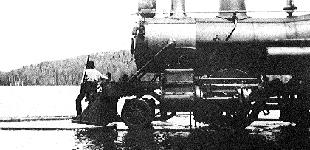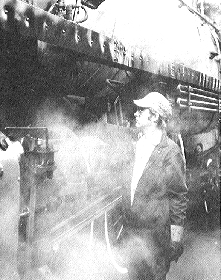
 |

Once upon a time, in 1871, there was a railroad incorporated as the Ottawa and Gatineau
Valley Railway. There was a great deal of talking done, but very little construction. In 1882 two people, including a
former mayor of Ottawa and another person, banded together to take control of the company. Then in 1883 the Canadian
Parliament got into the act by granting a series cash subsidies. By 1886 neither talk nor cash had produced any results
and a conflict occurred in which a third person came into control, H.J. Beemer. More subsidies were poured into the
company, and with the employment of two hundred men, work finally commenced. 1892 saw the railway reach Farrellton,
1893 Kazabazua, and in 1895, Gracefield. During 1894 the company was re-named the Ottawa and Gatineau
Railway, but only until 1901 when the name changed again to Ottawa Northern and Western Railway. In 1902 the ON&W
was leased to Canadian Pacific for 999 years. During the year 1908, the Gatineau River flooded its banks, which brings
us to the date of this photograph. A man on the locomotive pilot appears to shove logs aside while it progresses through
the flood at Wakefield, Quebec. This line carried manufactured goods, lumber, firewood, flour, grain, and livestock,
but most surprisingly, almost 61,000 passengers throughout 1901. If operated to capacity during 1981, National Museum
of Science and Technology's train will carry 7,350 passengers along this same route to Wakefield. (PA12923 Public
Archives Canada)
INTRODUCTION
Crabfat. There's not much fat on a crab. What you can find is useless, which is pretty much a
sailors opinion of anyone foolish enough to be in the Airforce. I tell you this because there is also a railroad man's
name, Daisypicker. Translated it means Railfan, but there's more to the word. Somewhat like the name Crabfat.
Daisypickers are who this story is written for, to, about, and by. Anyone who hears 1201's whistle and stops to listen,
even for a second, is picking daisies.
|
4
|
|
| |
 |
During morning preparations, Philip Jago of the Bytown Railway
Society reaches through escaping steam to close the water pump drain valve.
(W.C. Slim)
|
PREPARATIONS
Ottawa, 07:00 hours, with a forklift and chain 1201 is dragged backwards from its shed.
Another trip has begun. Once clear of the door and stopped, Museum Fireman Elliot disconnects the chain to attach it to
passenger car 3051. With the forklift pulling again, 3051 is coupled to 1201. 1201's stack cover is removed so that the
fire may be ignited. Lighting 1201's fire requires the assistance of two air compressors in parallel to provide air
pressure. This air is forced through the smoke box to provide a draft once the fire is lit. A portion is simultaneously
fed to the oil atomizer located under the fire box. As this air strikes oil supplied by the tender, its pressure atomizes
the oil so that it will burn. Oily cotton is lit and dropped into the spray, the oil ignites. Air must be continuously
supplied by the compressors until sixty pounds shows on the steam gauge, at this point 1201 can steam on her own. Steam
pressure rises rapidly, however, total time from lighting to full pressure of 200 pounds will take an hour and a half.
The Fireman must control this firing by regulating the oil flow and use of a damper underneath the firebox. An incorrect
setting produces copious black smoke, and indication of poor combustion, or lack of attention.
|
5
|
 |